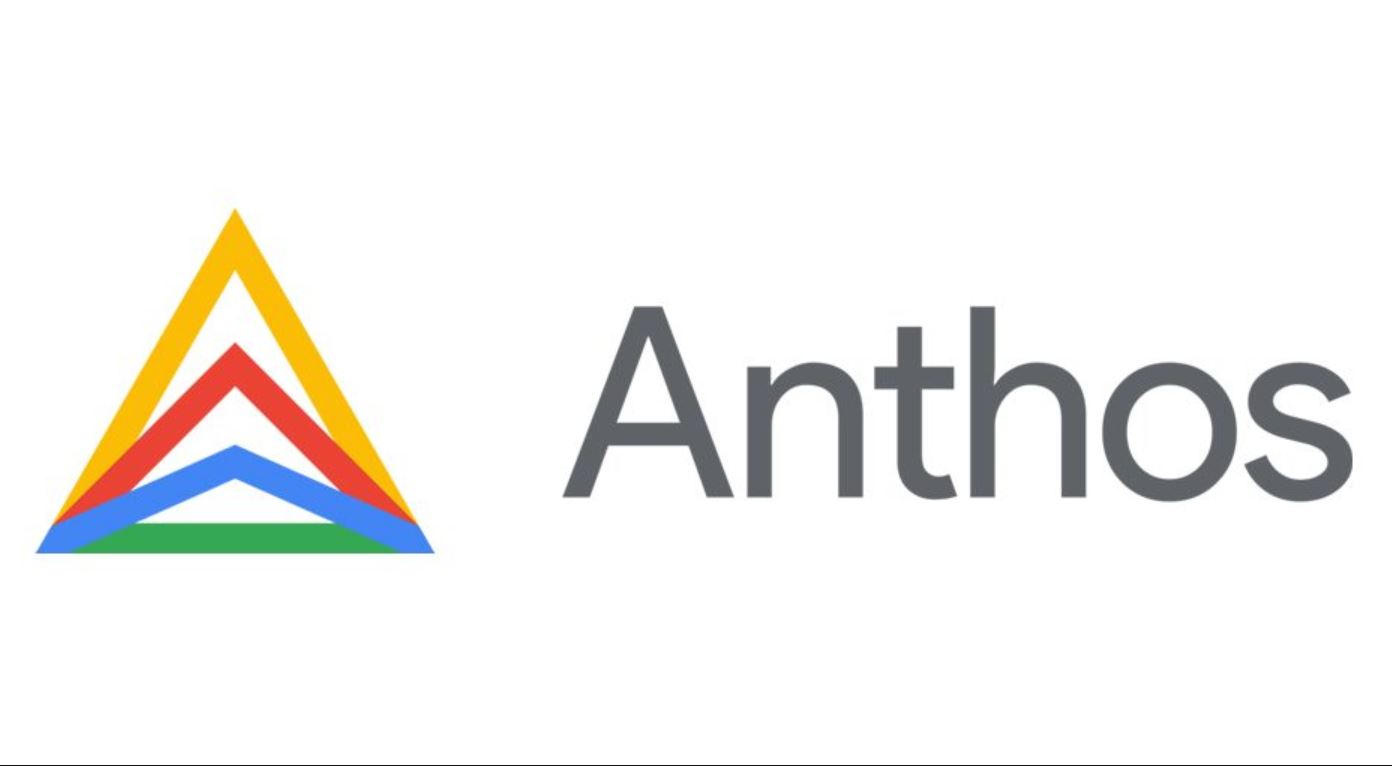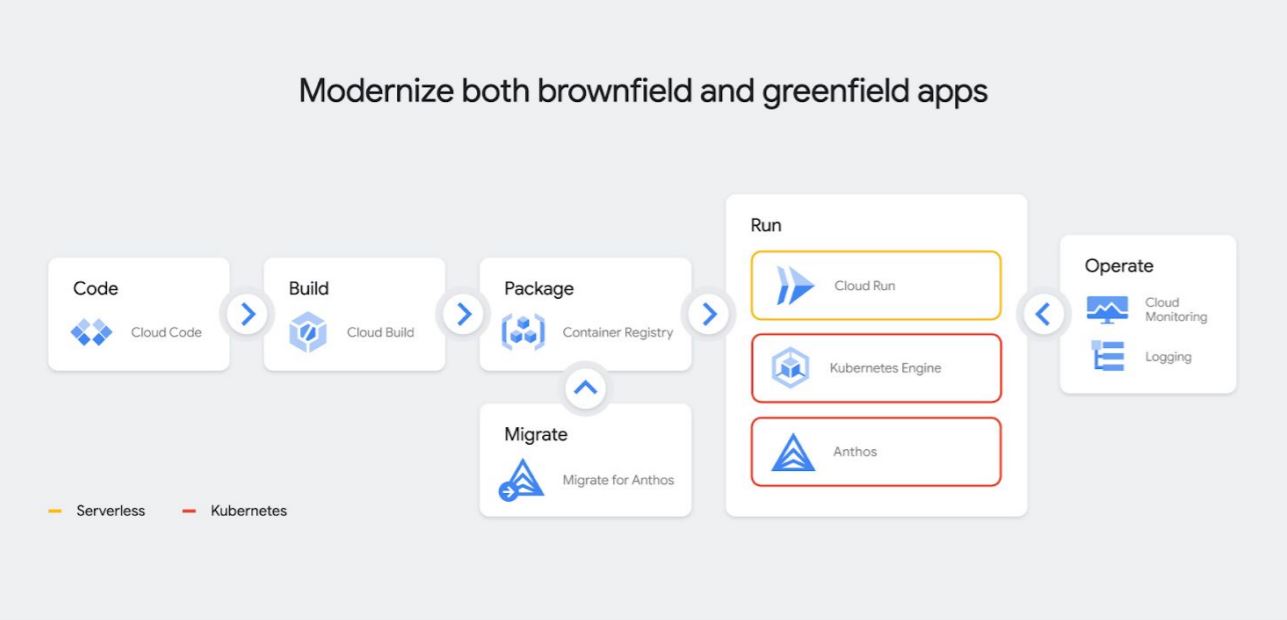 CLOUD
CLOUD
 CLOUD
CLOUD
 CLOUD
CLOUD
Google LLC today expanded the capabilities of its hybrid cloud application development platform Anthos, with an eye to helping companies modernize their most critical business applications.
To that end, Google also announced during its Cloud Next OnAir digital conference a new Global Cloud Application Modernization Program. CAMP is meant to help companies get started with their application modernization journey and maximize its impact on their business.
Google Anthos is a hybrid cloud application development platform that runs atop the open-source Kubernetes container orchestration software. It’s designed to host applications that can run unmodified on both existing on-premises hardware and public clouds, which gives companies the option to choose the most suitable infrastructure for each one.
With Anthos, applications are typically deployed in software containers, which are used to host the individual components of each app and make them easier to work with. Kubernetes plays a central role by making it easier to manage large clusters of containerized apps.
In an interview with SiliconANGLE, Pali Bhat, vice president of product and design at Google Cloud, said Anthos has been the subject of “tremendous interest” from customers in the last few quarters. “Digital has gone from being one of the channels to being the way to do business,” Bhat said.
He revealed that Google saw more than 100,000 customers use the company’s application modernization platform, which is comprised of Anthos, Google Kubernetes Engine, Cloud Run and Cloud Functions, during the second quarter. According to him, many of those customers are turning to Google’s tools to help them become more agile and innovate faster.
“We’re seeing customers looking to set the platform first rather than start with one application,” Bhat said. “That enables our customers to have business transformation that works for them.”
There’s no doubt that there’s a big demand for app modernization, but many of Google’s customers also want to incorporate the latest technological advancements into their new apps, including artificial intelligence. With that in mind, Google today announced new “hybrid AI capabilities” in Anthos designed to let customers use those technologies wherever their applications are hosted.
The Anthos hybrid AI capabilities are a work in progress, but the first of those offerings, called Speech-to-Text On-Prem, is now generally available for all customers via the Google Cloud Marketplace. With Speech-to-Text On-Prem, Google is giving users full control of their speech data within their own data centers for the first time, which means companies can now use the service and make sure they adhere to both data residency and compliance requirements.
“At the same time, Speech-to-Text On-Prem leverages state-of-the-art speech recognition models developed by Google’s research teams that are more accurate, smaller, and require less computing resources to run than existing solutions,” Eyal Manor, a general manager and vice president of engineering at Google Cloud, said in a blog post.
In addition, Google announced the availability of Anthos on bare metal servers in beta. The new service makes it possible to run Anthos at on-premises and edge locations without needing a hypervisor. The benefits of doing so are a more lightweight and cost-effective platform that can reduce unnecessary overheads and therefore, the associated costs of these. In addition, Anthos on bare metal will open up new cloud and edge use cases, as Google has found out for itself.
“Google is itself an early adopter for Anthos for bare metal, working towards using it as a platform to run containers internally for our production workloads,” Manor said.
Also new today is Anthos attached clusters, which is a new capability that allows developers to bring Kubernetes-conformant clusters into Anthos. This lets developers manage any Kubernetes cluster using the Anthos control plane, providing more centralized management for configuration and service mesh capabilities, Manor said. It also means developers can take advantage of Anthos’ service automation tools.
Another update announced today is meant to speed up developer cycles, Manor said. Google has united its Cloud Code Integrated Development Environment plugins with Cloud Run for Anthos, making it possible to build serverless applications directly from IDEs such as VS Code and Intellij.
“Once you’ve written your code, the new Cloud Code-Cloud Run emulator lets you quickly validate local changes on your own machine, with automated re-deploys on every saved code change,” Manor said. “You can even use this emulator to locally debug your Cloud Run apps. When your code is ready, you can push changes directly to a remote dev environment in the cloud, right from the IDE.”
On the security side, the new Anthos Identity Service makes it possible for customers to extend their existing identity services to Anthos applications and workloads. Meanwhile, the new Anthos security blueprints announced today provide best practices for developers in a templated format. This is meant to make it easier to adopt best practices for tasks such as auditing and monitoring, policy enforcement and enforcing locality restrictions.
“Anthos security blueprints also give you purpose-built solutions to automate governance, compliance and data residency for regulated industries such as financial services, retail and public sector,” Manor said.
The new Anthos capabilities were announced as Google launched its new Cloud Application Modernization Program that’s meant to help companies get started with their application modernization journeys. Google said doing so can be a major headache for large enterprises because many simply don’t know where to begin.
“Common hurdles revolve around maintaining visibility and control across disparate on-prem, hybrid, and cloud environments, often resulting in a disjointed developer experience,” Oren Teich, CAMP product management director, wrote in a blog post. “Additionally, navigating the modernization path necessitates an understanding of how to drive continuous progress, while leveraging the right metrics to guide business and IT decisions. Finally, while changing culture is critical, common pitfalls include treating transformation as a one-time project or driving app modernization as a top-down effort.”
The Google CAMP program comprises three stages that are meant to help customers to address those challenges, Bhat told SiliconANGLE. The first stage is data-driven assessment and benchmarking, which helps customers to assess exactly where they’re at, and which areas they need to improve first of all.
The assessment is fairly detailed, tailored to each organization and helps them to benchmark each line of its business against other areas of its company, the overall industry and specific leaders within that industry. The final assessment, an example of which is below, reveals where the company’s bottlenecks are and where they can make the biggest and most impactful investments, Google said.

Following that, Bhat said Google CAMP then comes up with tailored set of best practices and a program for app modernization that maximizes the return on investment.
Finally, stage three sees Google provide implementation recommendations that cover the full gamut of the application lifecycle, from writing code to running, operating and securing applications.

“Examples of these practices include driving alignment between developers and operators, lean product development, and technical practices such as implementing loosely coupled architectures, continuous testing, and more,” Teich said. “Modernizing applications and software development processes is one of the hardest challenges facing today’s enterprises. With Google CAMP, large organizations across all industries can modernize to generate powerful business outcomes.”
Constellation Research Inc. analyst Holger Mueller told SiliconANGLE that Google was doubling down on the value proposition of “build once, deploy everywhere” that Anthos offers developers. He said that most developers and companies want to avoid refactoring and porting code to different platforms and paying for those efforts with time and money.
“Anthos is Google’s platform for enabling that, offering key multicloud and hybrid cloud features,” Mueller said. “With the addition of bare metal support for Anthos, enterprises get even more deployment options, both taking advantage of the best of cloud and best of on-premises. This makes Anthos a next-generation compute platform that competes in scope with Red Hat, Microsoft Azure Stack and Amazon Outposts. The big differentiator to the IaaS competitors is the multicloud support Google offers.”
THANK YOU